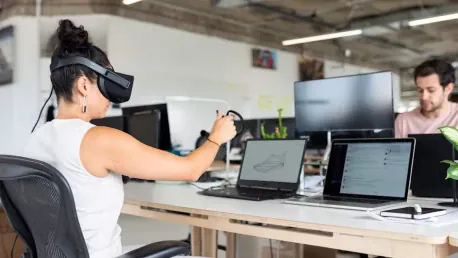Data from the Dell & Intel Future Workforce Study shows that global employees are ready to work in smart workspaces, and they expect them in the near future. In fact, 44% of respondents said that their workspaces are not smart enough, with only 8% complaining that they are too smart. More data from Dell & Intel’s study reveals that:
42% of Millennials are likely to quit a job due to substandard technology.
66% of workers are open to using AR/VR in the workplace in the near future.
77% are willing to use AR/VR products at work.
76% of remote workers are willing to use VR for work.
It’s clear that more and more employees are starting to view virtual reality as a catalyzer of improved collaboration. Below we’ve listed a few ways in which virtual reality can benefit the modern workspace.
Remote Collaboration
If technology was ever thought to impair human relationships and collaboration, virtual reality is the perfect counterexample. VR will take collaboration to a whole new level. Just think about it: instead of using Skype to connect with team members from different geographical locations, virtual reality will bring employees together in an immersive experience, “offering everything from comprehensive data visualization to setting up digital conferences. VR is advancing so quickly that virtual collaboration might replace the office entirely one day”, says Anthony Coggine on TechWell.com.
More so, according to The New York Times, the number of employed Americans working remotely has increased by 4% since 2012. It’s safe to say that VR will accelerate this trend by enabling employees to digitally connect with one another and be in the same room (virtually speaking), even if they are a thousand miles apart.
Safe Testing in Controlled Environments
What makes VR such a great tool when it comes to employee training? Safety. VR can be extremely useful in training people for tasks that are challenging and physically dangerous. Take flight simulators for instance; VR not only enhances the entire experience, but it also allows future pilots to experience the conditions and challenges that come with operating an aircraft. Not only that, but it also minimizes the risks involved, and decreases the costs associated with training and infrastructure.
“With the use of compatible virtual reality gadgets, an entirely new and interactive world is created to train employees who work in risky work environments. They refine their skills to deal with hazardous wastes or work at accident-prone construction sites, thus avoiding injuries and mitigating risks involved”, according to eLearningIndustry.com.
Corporate Training
Traditional corporate learning sessions can be dull – to say the least. And since curiosity is known to aid the learning process, what better way to enable your employees to absorb huge amounts of information and perfect their skills than through augmented virtual reality sessions? By immersing yourself in a fun, safe, creative environment, completely detached from all external distractions, you are far less likely to lose focus, which means you retain information more easily, resulting in more effectual learning.
And it’s not just the employee who benefits from the use of VR in corporate training – organizations too stand to win. “Virtual Reality makes the learning environment more convenient by saving organizations’ time as well as budget. Employees don’t need to travel to attend training programs and can take up courses at the point of need. For instance, architects across the world can assess their designs using VR and collaborate further without any hassle”.
Hiring Top Talent
So far, we’ve discussed how VR can enable us to do our jobs more effectively. But what if it could help us get a job in the first place? According to Forbes.com, “talent acquisition is another emerging application for Virtual Reality in the workplace. VR now lets prospective hires inhabit the workplaces and environments their new job requires. It lets them experience their possible future hands-on and in a deeply immersive way so they can make a fully informed decision about pursuing that particular position or field of work”. It’s a win-win situation for both the employer and the prospective candidate.









